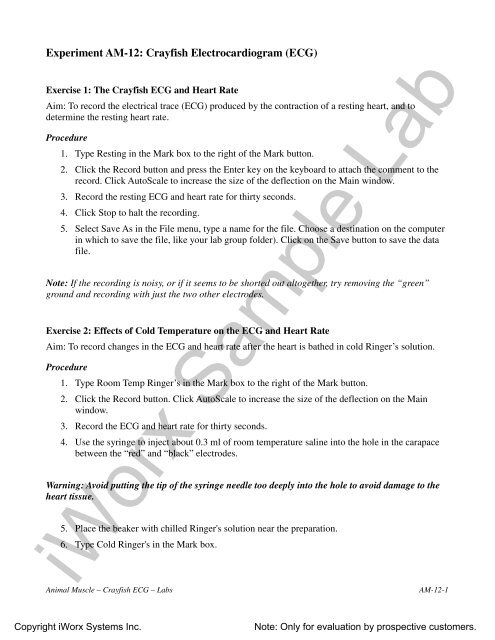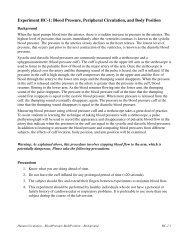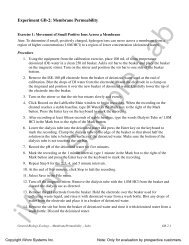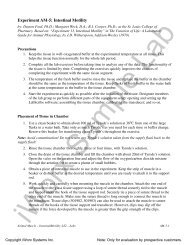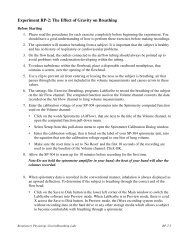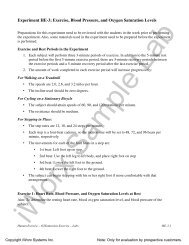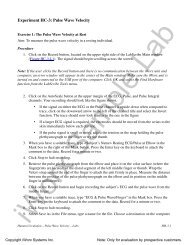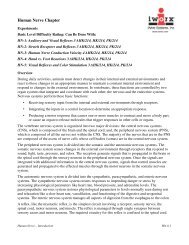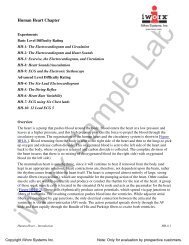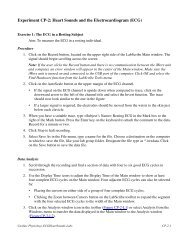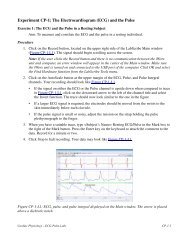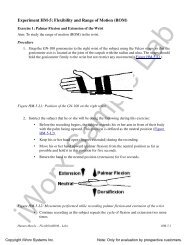Experiment AM-12: Crayfish Electrocardiogram (ECG) - iWorx
Experiment AM-12: Crayfish Electrocardiogram (ECG) - iWorx
Experiment AM-12: Crayfish Electrocardiogram (ECG) - iWorx
Create successful ePaper yourself
Turn your PDF publications into a flip-book with our unique Google optimized e-Paper software.
<strong>Experiment</strong> <strong>AM</strong>-<strong>12</strong>: <strong>Crayfish</strong> <strong>Electrocardiogram</strong> (<strong>ECG</strong>)Exercise 1: The <strong>Crayfish</strong> <strong>ECG</strong> and Heart RateAim: To record the electrical trace (<strong>ECG</strong>) produced by the contraction of a resting heart, and todetermine the resting heart rate.Procedure1. Type Resting in the Mark box to the right of the Mark button.2. Click the Record button and press the Enter key on the keyboard to attach the comment to therecord. Click AutoScale to increase the size of the deflection on the Main window.3. Record the resting <strong>ECG</strong> and heart rate for thirty seconds.4. Click Stop to halt the recording.5. Select Save As in the File menu, type a name for the file. Choose a destination on the computerin which to save the file, like your lab group folder). Click on the Save button to save the datafile.Note: If the recording is noisy, or if it seems to be shorted out altogether, try removing the “green”ground and recording with just the two other electrodes.Exercise 2: Effects of Cold Temperature on the <strong>ECG</strong> and Heart RateAim: To record changes in the <strong>ECG</strong> and heart rate after the heart is bathed in cold Ringer’s solution.Procedure1. Type Room Temp Ringer’s in the Mark box to the right of the Mark button.2. Click the Record button. Click AutoScale to increase the size of the deflection on the Mainwindow.3. Record the <strong>ECG</strong> and heart rate for thirty seconds.4. Use the syringe to inject about 0.3 ml of room temperature saline into the hole in the carapacebetween the “red” and “black” electrodes.Warning: Avoid putting the tip of the syringe needle too deeply into the hole to avoid damage to theheart tissue.5. Place the beaker with chilled Ringer's solution near the preparation.6. Type Cold Ringer's in the Mark box.<strong>iWorx</strong> Sample LabAnimal Muscle – <strong>Crayfish</strong> <strong>ECG</strong> – Labs<strong>AM</strong>-<strong>12</strong>-1Copyright <strong>iWorx</strong> Systems Inc.Note: Only for evaluation by prospective customers.
7. Twenty seconds after the addition of room temperature Ringer’s to the heart, apply 0.3 ml of thecold Ringer’s solution through the hole in the carapace. Repeat two more times, leaving 10seconds between applications.8. Press the Enter key on the keyboard after the third application of cold Ringer’s solution.9. Record until the heart has recovered from the effects of cold Ringer’s solution.Note: Recovery is when the <strong>ECG</strong> amplitudes and rate of the heart contraction have returned to theresting values.10. Click Stop to halt the recording.11. Select Save in the File menu.<strong>12</strong>. Use the syringe to inject about 0.3 ml of room temperature saline onto the heart.Exercise 3: Effects of Warm Temperature on the <strong>ECG</strong> and Heart RateAim: To record changes in the <strong>ECG</strong> and heart rate after the heart is bathed in warm Ringer’s solution.Procedure1. Type Room Temp Ringer’s in the Mark box to the right of the Mark button.2. Click the Record button. Click AutoScale to increase the size of the deflection on the Mainwindow.3. Record the <strong>ECG</strong> and heart rate for thirty seconds.4. Apply 0.3 ml of Ringer's solution (at room temperature) to the heart. Press the Enter key on thekeyboard when the Ringer’s solution is injected onto the heart.5. Place the beaker with warm Ringer's solution near the preparation.6. Type Warm Ringer's in the Mark box.7. Twenty seconds after the addition of room temperature Ringer’s to the heart, apply 0.3 ml ofwarm Ringer's solution to the heart. Repeat two more times. leaving 10 seconds betweenapplications.8. Press the Enter key on the keyboard after the third application of warm Ringer’s solution.9. Record until the heart has recovered from the effects of warm Ringer’s solution.Note: Recovery is when the <strong>ECG</strong> amplitudes and rate of the heart contraction have returned to theresting values.10. Click Stop to halt the recording.<strong>iWorx</strong> Sample Lab11. Select Save in the File menu.<strong>12</strong>. Use the syringe to inject about 0.3 ml of room temperature saline onto the heart.Animal Muscle – <strong>Crayfish</strong> <strong>ECG</strong> – Labs<strong>AM</strong>-<strong>12</strong>-2Copyright <strong>iWorx</strong> Systems Inc.Note: Only for evaluation by prospective customers.
Exercise 4: Effects of Drugs on the <strong>Crayfish</strong> HeartAim: To monitor the effects of serotonin and GABA on the <strong>ECG</strong> amplitudes and rate of heartcontraction.Procedure - Serotonin1. Type Resting in the Mark box to the right of the Mark button.2. Click the Record button. Press the Enter key on the keyboard to mark the recording. ClickAutoScale to increase the size of the deflection on the Main window.3. Record the <strong>ECG</strong> and heart rate for thirty seconds.4. Type 0.01 mM Serotonin in the Mark box to the right of the Mark button.5. Apply 0.3 ml of 0.01 mM serotonin solution (at room temperature) to the heart. Repeat twomore times. leaving 10 seconds between applications.6. Press the Enter key on the keyboard after the third application of 0.01 mM Serotonin.7. If you didn’t see a clear response, repeat steps 4-6 with 0.1 mM serotonin.8. After recording the effects of serotonin for sixty seconds, inject 0.3 ml of room temperatureRinger’s solution onto the heart at 10 second intervals until the <strong>ECG</strong> and heart rate return to theresting state.9. Click Stop to halt the recording.10. Select Save in the File menu.11. Inject 0.3 ml of room temperature Ringer’s solution onto the heart.Procedure - GABA1. Type 0.01 mM GABA in the Mark box to the right of the Mark button.2. Click the Record button. Click AutoScale to increase the size of the deflection on the Mainwindow.3. Record the <strong>ECG</strong> and heart rate for thirty seconds.4. Apply 0.3 ml of 0.01 mM GABA solution (at room temperature) to the heart. Repeat two moretimes. leaving 10 seconds between applications.5. Press the Enter key on the keyboard after the third GABA application. Continue recording.Warning: If the heart goes into cardiac arrest, rinse the GABA solution off the heart with fresh,room temperature Ringer’s solution. If the heart is still in cardiac arrest after 10 seconds, add 0.3 mlof 0.01 mM Serotonin solution to the heart.6. If you don’t see a clear response to the 0.01 mM GABA, repeat steps 1-5 with 0.1 mM GABA.7. After recording the effects of GABA for sixty seconds, rinse the heart with room temperatureRinger’s solution until the <strong>ECG</strong> and heart rate return to the resting rate.<strong>iWorx</strong> Sample LabAnimal Muscle – <strong>Crayfish</strong> <strong>ECG</strong> – Labs<strong>AM</strong>-<strong>12</strong>-3Copyright <strong>iWorx</strong> Systems Inc.Note: Only for evaluation by prospective customers.
8. Click Stop to halt the recording.9. Select Save in the File menu.10. Apply 0.3 ml of room temperature saline to the heart.Data AnalysisExercise 1: Resting Heart Rate1. Scroll to the resting heart rate data. Click the AutoScale button to maximize the size of the <strong>ECG</strong>and heart rate channels on the window (Figure <strong>AM</strong>-<strong>12</strong>-L1).Figure <strong>AM</strong>-<strong>12</strong>-L1: <strong>Crayfish</strong> <strong>ECG</strong> and heart rate displayed on the Main Window.2. Use the Display Time icons to adjust the Display Time of the Main window to show fivecomplete cardiac cycles on the Main window. The cycles can be selected by:• Placing a cursor before the first deflection, and a cursor before the sixth deflection; and• Clicking the Zoom between Cursors button on the LabScribe toolbar to expand the fiveselected cardiac cycles to the width of the Main window.3. Click on the Analysis window icon in the toolbar (Figure <strong>AM</strong>-<strong>12</strong>-L2) or select Analysis fromthe Windows menu to transfer the data displayed in the Main window to the Analysis window.4. Look at the Function Table that is above the uppermost channel displayed in the Analysiswindow. The mathematical functions, V2-V1 and Mean should appear in this table. The valuesfor V2-V1 and Mean for each channel are seen in the table across the channel’s top margin.<strong>iWorx</strong> Sample LabAnimal Muscle – <strong>Crayfish</strong> <strong>ECG</strong> – Labs<strong>AM</strong>-<strong>12</strong>-4Copyright <strong>iWorx</strong> Systems Inc.Note: Only for evaluation by prospective customers.
Figure <strong>AM</strong>-<strong>12</strong>-L2: The LabScribe toolbar.5. The value for Mean on the Heart Rate (<strong>Crayfish</strong> <strong>ECG</strong>) channel is the mean heart rate for thefive cycle period.Note: Because the depolarization waves are of fluctuating height and direction, it may be necessary toinvert the trace or reconfigure the Periodic setup in order to detect all the heart beats. To invert thetrace, select Invert from the <strong>Crayfish</strong> <strong>ECG</strong> channel menu. To adjust the Periodic setup, click on P. Rate(<strong>Crayfish</strong> <strong>ECG</strong>) in the Heart Rate channel bar and choose Setup Function. Adjust the Threshold andTolerance lines so that they pass through the Depolarization wave of each cycle.Exercise 2: Effect of Cold Temperature1. Scroll to the data recorded from the heart fifteen seconds before cold Ringer’s solution wasadded to the heart. Click the AutoScale button to maximize the size of the <strong>ECG</strong> and heart ratechannels on the window.2. Use the Display Time icons to adjust the Display Time of the Main window to show fivecomplete cardiac cycles on the Main window.3. Transfer the data displayed in the Main window to the Analysis window.4. Values for V2-V1 and Mean are seen in the Function Table across the top margin of eachchannel.5. Once the cursors are placed in the correct positions for determining the heart rate and theamplitude of each cardiac parameter, the values of the parameters in the Function Table can berecorded in the on-line notebook of LabScribe by typing their names and values directly into theJournal, or on a separate data table.6. The functions in the channel pull-down menus of the Analysis window can also be used to enterthe names and values of the parameters from the recording to the Journal. To use thesefunctions:• Place the cursors at the locations used to measure the heart rate and the amplitude ofeach cardiac parameter.<strong>iWorx</strong> Sample Lab• Transfer the names of the mathematical functions used to determine the amplitude andAnimal Muscle – <strong>Crayfish</strong> <strong>ECG</strong> – Labs<strong>AM</strong>-<strong>12</strong>-5Copyright <strong>iWorx</strong> Systems Inc.Note: Only for evaluation by prospective customers.
times to the Journal using the Add Title to Journal function in the <strong>Crayfish</strong> <strong>ECG</strong> Channelpull-down menu.• Transfer the amplitude values to the Journal using the Add Ch. Data to Journal functionin the <strong>Crayfish</strong> <strong>ECG</strong> Channel pull-down menu.• Transfer the average rate over the selected cycles to the Journal using the Add Ch. Datato Journal function in the Heart Rate (<strong>Crayfish</strong> <strong>ECG</strong>) Channel pull-down menu.7. On the <strong>Crayfish</strong> <strong>ECG</strong> Channel, use the mouse to click on and drag the cursors to specific pointson the recording to measure the following parameters:• The Depolarization wave amplitude. To measure the amplitude of the Depolarizationwave, place one cursor on the positive peak and the second cursor on the negative peakof the Depolarization wave, as illustrated in Figure <strong>AM</strong>-<strong>12</strong>-L3. The value for V2-V1 onthe <strong>Crayfish</strong> <strong>ECG</strong> channel is this amplitude. Measure the amplitudes of four additionaldepolarization waves.• The Repolarization wave amplitude, To measure the amplitude of the Repolarizationwave, place one cursor on the baseline before the Repolarization wave and the secondcursor on the peak of the Repolarization wave. The value for V2-V1 on the <strong>Crayfish</strong><strong>ECG</strong> channel is this amplitude. Measure the amplitudes of four additionalRepolarization waves.• Mean Heart Rate, is the average heart rate calculated from the <strong>Crayfish</strong> <strong>ECG</strong> Channel.To measure this parameter, place one cursor at the beginning of the first of five cardiaccycles selected and the second cursors at the end of the cycles selected. The value forMean on the Heart Rate (<strong>Crayfish</strong> <strong>ECG</strong>) channel is this mean heart rate for that fivecycle period.Figure <strong>AM</strong>-<strong>12</strong>-L3: <strong>Crayfish</strong> <strong>ECG</strong> and heart rate displayed in the Analysis window. The cursors areplaced to measure the amplitude of the depolarization wave.<strong>iWorx</strong> Sample LabAnimal Muscle – <strong>Crayfish</strong> <strong>ECG</strong> – Labs<strong>AM</strong>-<strong>12</strong>-6Copyright <strong>iWorx</strong> Systems Inc.Note: Only for evaluation by prospective customers.
8. Record the values in the Journal using the one of the techniques described in Steps 6 or 7, andon Table <strong>AM</strong>-<strong>12</strong>-L1.9. Scroll to the section of data recorded when cold Ringer’s solution was added to the heart. ClickAutoScale to maximize the size of the response on the window.10. Repeat these steps to measure and record the various amplitudes and heart rate at the time thecold Ringer’s solution was added to the heart and at 10 second intervals for the first minuteafter the addition of the cold Ringer’s.11. Measure and record the <strong>ECG</strong> amplitudes and the heart rate at the end of the recovery periodfrom the effects of cold Ringer’s.<strong>12</strong>. Select Save in the File menu.Exercise 3: Effect of Warm Temperature1. Scroll to the data recorded from the heart fifteen seconds before warm Ringer’s solution wasadded to the heart. Click the AutoScale button to maximize the size of the <strong>ECG</strong> and heart ratechannels on the window.2. Use the same techniques used in Exercise 2 to measure the <strong>ECG</strong> amplitudes and heart ratesduring the rest, treatment, and recovery periods when warm Ringer’s was applied to the heart.3. Record your data in Table <strong>AM</strong>-<strong>12</strong>-L1.Exercise 4: Drug Effects1. Scroll to the beginning of the data from Exercise 4 and find the normal heart contractions thatoccurred before the first drug treatment.2. Use the same techniques used in Exercise 2 to measure the <strong>ECG</strong> amplitudes and heart ratesduring the rest, treatment, and recovery periods for the two drugs applied to the heart.3. Record the values for the amplitudes and heart rates from this exercise in the Journal and onTable <strong>AM</strong>-<strong>12</strong>-L2 for Serotonin and Table <strong>AM</strong>-<strong>12</strong>-L3 for GABA<strong>iWorx</strong> Sample LabAnimal Muscle – <strong>Crayfish</strong> <strong>ECG</strong> – Labs<strong>AM</strong>-<strong>12</strong>-7Copyright <strong>iWorx</strong> Systems Inc.Note: Only for evaluation by prospective customers.
Table <strong>AM</strong>-<strong>12</strong>-L1: Amplitudes and Rate of Heart Contractions at Different Temperatures.TreatmentRoom Temp Ringer’sCold Ringer’s10 sec after Cold Ringer’s20 sec after Cold Ringer’s30 sec after Cold Ringer’s40 sec after Cold Ringer’s50 sec after Cold Ringer’s60 sec after Cold Ringer’sRecovered from ColdRoom Temp Ringer’sWarm Ringer’s10sec after Warm Ringer’s20sec after Warm Ringer’s30sec after Warm Ringer’s40sec after Warm Ringer’s50sec after Warm Ringer’s60sec after Warm Ringer’sRecovered from Heat<strong>Crayfish</strong> <strong>ECG</strong>Depolarization Wave(V)Repolarization Wave(V)Mean Heart Rate(BPM)<strong>iWorx</strong> Sample LabAnimal Muscle – <strong>Crayfish</strong> <strong>ECG</strong> – Labs<strong>AM</strong>-<strong>12</strong>-8Copyright <strong>iWorx</strong> Systems Inc.Note: Only for evaluation by prospective customers.
Table <strong>AM</strong>-<strong>12</strong>-L2: Amplitudes and Rate of Heart Contraction with Serotonin Treatment.Frog <strong>ECG</strong>Treatment Depolarization Wave (V) Repolarization Wave (V)RestingSerotonin10 sec after Serotonin20 sec after Serotonin30 sec after Serotonin40 sec after Serotonin50 sec after Serotonin60 sec after SerotoninRecoveredHeart Rate(BPM)Table <strong>AM</strong>-<strong>12</strong>-L3: Amplitudes and Rate of Heart Contraction with GABA Treatment.Frog <strong>ECG</strong>Treatment Depolarization Wave (V) Repolarization Wave (V)RestingGABA10 sec after GABA20 sec after GABA30 sec after GABA40 sec after GABA50 sec after GABA60 sec after GABARecoveredHeart Rate(BPM)<strong>iWorx</strong> Sample LabAnimal Muscle – <strong>Crayfish</strong> <strong>ECG</strong> – Labs<strong>AM</strong>-<strong>12</strong>-9Copyright <strong>iWorx</strong> Systems Inc.Note: Only for evaluation by prospective customers.
Questions1. What is the effect of cold Ringer's solution on heart rate and the amplitude of the ventriculardepolarization? What mechanism is responsible for this effect?2. How does warm Ringer’s affect the heart? How do the wave amplitudes and heart rate differfrom when cold Ringer’s was applied to the heart?3. What effect does Serotonin have on the heart rate and the amplitudes of the <strong>ECG</strong> waves?4. How does Serotonin produce its effects on the heart rate and the amplitude of the ventricularcontraction specifically?5. What effect does GABA have on the heart rate and the amplitude of the <strong>ECG</strong> waves?6. How does GABA produce its effects on the heart rate and the amplitude of the ventricularcontraction specifically?7. Do the time courses for the effect of each drug on the amplitude and the rate of ventricularcontraction differ?Suggested Variations1. Although Serotonin and GABA are more appropriate to crustaceans, what are the effects of thevertebrate cardiac transmitters, Epinephrine and Acetylcholine?2. Use a force transducer to measure and record the heart rate and force of contraction under thesame conditions using the methods in <strong>Experiment</strong> <strong>AM</strong>-7.<strong>iWorx</strong> Sample LabAnimal Muscle – <strong>Crayfish</strong> <strong>ECG</strong> – Labs<strong>AM</strong>-<strong>12</strong>-10Copyright <strong>iWorx</strong> Systems Inc.Note: Only for evaluation by prospective customers.


